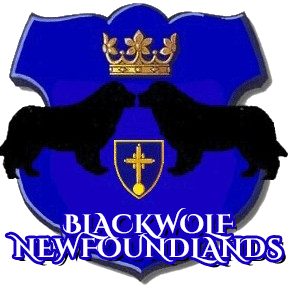WORKING GROUP
The Newfoundland
Is known for its sweet disposition, intelligence, and versatility. A devoted companion and multipurpose dog, the Newfoundland excels both on land and in water. Known for its natural lifesaving abilities and strength, the breed is also well-suited for draft work. Its gentle temperament and loyalty make it beloved around the world.
General Appearance
The Newfoundland is a large, heavily coated, well-balanced dog. Strong, muscular, and deep-bodied, it carries itself with dignity and pride. This breed is noted for its calm, gentle nature, never displaying dullness or ill temper. Any deviation from the ideal appearance is penalized according to the extent of the fault. Structural and movement faults common to all working dogs are equally undesirable in the Newfoundland.
Size, Proportion, and Substance
Height: Adult males average 28 inches, females 26 inches.
Weight: Males typically weigh between 130-150 pounds, females 100-120 pounds.
While size is desirable, balance, structure, and proper gait should never be sacrificed. The Newfoundland’s body is slightly longer than it is tall, with substantial spring of rib, strong muscles, and heavy bone.
Head
The Newfoundland’s head is massive, with a broad skull and a slightly arched crown. The eyes are dark brown (or lighter in Browns and Grays, without affecting expression) and are set wide apart. The ears are small, triangular with rounded tips, lying close to the head. The muzzle is broad and deep, with teeth meeting in a scissors or level bite. Expression is soft, reflecting the dog’s benevolent, intelligent, and dignified nature.
Neck, Topline, and Body
The neck is strong and well-set on muscular shoulders, long enough for a proud head carriage. The back is broad and level, with a deep chest reaching at least to the elbows. The tail follows the natural line of the croup and is strong, reaching to the hock. The tail hangs straight when the dog is relaxed and is carried out but not curled over the back when the dog is excited or in motion.
Forequarters
The shoulders are muscular and well-laid back, with forelegs that are straight, heavily boned, and muscular. The pasterns are strong with a slight slope, and the feet are proportionate, webbed, and cat-footed. Dewclaws may be removed.
Hindquarters
The hindquarters are powerful, heavily boned, and muscular. Viewed from the rear, the legs are straight and parallel, with broad, long thighs and well-bent stifles and hocks. The hind feet are similar to the front. Dewclaws should be removed.
Coat
The Newfoundland’s coat is a flat, water-resistant double coat. The outer coat is coarse, moderately long, and may be straight or slightly wavy. The undercoat is soft and dense, though it may be less thick during warmer months. The coat on the face and muzzle is short, while the back legs and tail have feathering. Excess hair may be trimmed for neatness, though whiskers need not be trimmed.
Color
Color is secondary to the Newfoundland’s type, structure, and soundness. Recognized colors include black, brown, gray, and white and black:
- Solid Colors: Blacks, Browns, and Grays may have white markings on the chin, chest, toes, or tip of the tail, which is typical and not penalized.
- Landseer: White base coat with black markings, typically on the head, saddle, and rump, extending onto the tail. Clear white or minimal ticking is preferred.
Disqualifications include any colors or combinations of colors not specifically described.
Gait
The Newfoundland moves with smooth, rhythmic strides that convey effortless power. Its gait covers maximum ground with minimal steps, and legs move straight forward. As speed increases, legs tend to single track. A slight roll of the skin is characteristic of the breed. Proper movement is achieved by a balanced front and rear assembly.
Temperament
The defining trait of the Newfoundland is its sweetness of temperament. This gentle, calm demeanor is the most important characteristic of the breed and is highly valued in any Newfoundland.
Disqualifications
Any color or combination of colors not specifically described in the breed standard is grounds for disqualification.
